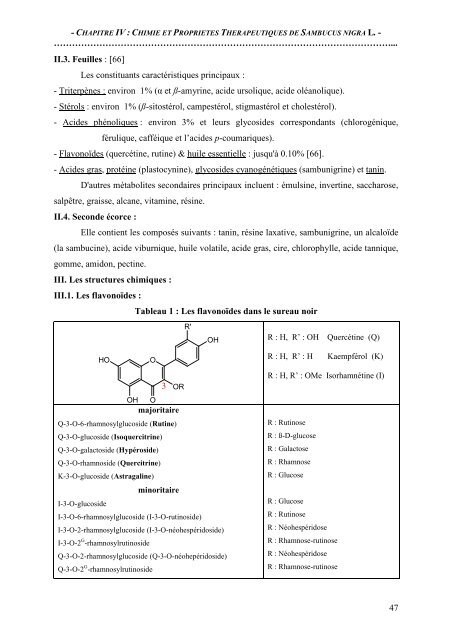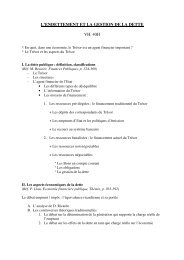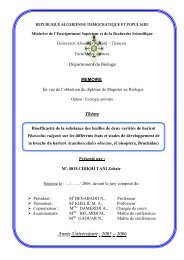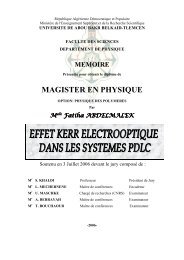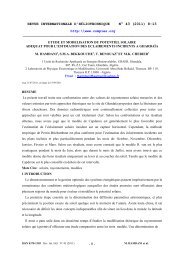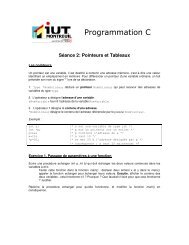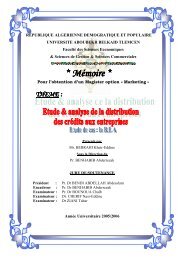Page de garde - Université de Tlemcen
Page de garde - Université de Tlemcen
Page de garde - Université de Tlemcen
You also want an ePaper? Increase the reach of your titles
YUMPU automatically turns print PDFs into web optimized ePapers that Google loves.
- CHAPITRE IV : CHIMIE ET PROPRIETES THERAPEUTIQUES DE SAMBUCUS NIGRA L. -<br />
…………………………………………………………………………………………………...<br />
II.3. Feuilles : [66]<br />
Les constituants caractéristiques principaux :<br />
- Triterpènes : environ 1% (α et ß-amyrine, aci<strong>de</strong> ursolique, aci<strong>de</strong> oléanolique).<br />
- Stérols : environ 1% (ß-sitostérol, campestérol, stigmastérol et cholestérol).<br />
- Aci<strong>de</strong>s phénoliques : environ 3% et leurs glycosi<strong>de</strong>s correspondants (chlorogénique,<br />
férulique, cafféique et l’aci<strong>de</strong>s p-coumariques).<br />
- Flavonoï<strong>de</strong>s (quercétine, rutine) & huile essentielle : jusqu'à 0.10% [66].<br />
- Aci<strong>de</strong>s gras, protéine (plastocynine), glycosi<strong>de</strong>s cyanogénétiques (sambunigrine) et tanin.<br />
D'autres métabolites secondaires principaux incluent : émulsine, invertine, saccharose,<br />
salpêtre, graisse, alcane, vitamine, résine.<br />
II.4. Secon<strong>de</strong> écorce :<br />
Elle contient les composés suivants : tanin, résine laxative, sambunigrine, un alcaloï<strong>de</strong><br />
(la sambucine), aci<strong>de</strong> viburnique, huile volatile, aci<strong>de</strong> gras, cire, chlorophylle, aci<strong>de</strong> tannique,<br />
gomme, amidon, pectine.<br />
III. Les structures chimiques :<br />
III.1. Les flavonoï<strong>de</strong>s :<br />
HO<br />
Tableau 1 : Les flavonoï<strong>de</strong>s dans le sureau noir<br />
O<br />
OR<br />
OH O<br />
majoritaire<br />
Q-3-O-6-rhamnosylglucosi<strong>de</strong> (Rutine)<br />
Q-3-O-glucosi<strong>de</strong> (Isoquercitrine)<br />
Q-3-O-galactosi<strong>de</strong> (Hypérosi<strong>de</strong>)<br />
Q-3-O-rhamnosi<strong>de</strong> (Quercitrine)<br />
K-3-O-glucosi<strong>de</strong> (Astragaline)<br />
I-3-O-glucosi<strong>de</strong><br />
3<br />
minoritaire<br />
I-3-O-6-rhamnosylglucosi<strong>de</strong> (I-3-O-rutinosi<strong>de</strong>)<br />
R'<br />
OH<br />
I-3-O-2-rhamnosylglucosi<strong>de</strong> (I-3-O-néohespéridosi<strong>de</strong>)<br />
I-3-O-2 G -rhamnosylrutinosi<strong>de</strong><br />
Q-3-O-2-rhamnosylglucosi<strong>de</strong> (Q-3-O-néohepéridosi<strong>de</strong>)<br />
Q-3-O-2 G -rhamnosylrutinosi<strong>de</strong><br />
R : H, R’ : OH Quercétine (Q)<br />
R : H, R’ : H Kaempférol (K)<br />
R : H, R’ : OMe Isorhamnétine (I)<br />
R : Rutinose<br />
R : ß-D-glucose<br />
R : Galactose<br />
R : Rhamnose<br />
R : Glucose<br />
R : Glucose<br />
R : Rutinose<br />
R : Néohespéridose<br />
R : Rhamnose-rutinose<br />
R : Néohespéridose<br />
R : Rhamnose-rutinose<br />
47


